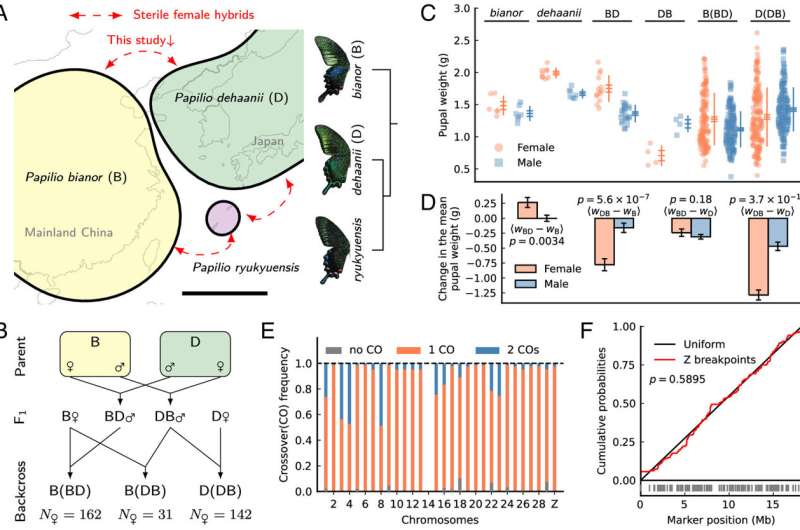This article has been reviewed according to Science X's editorial process and policies. Editors have highlighted the following attributes while ensuring the content's credibility:
fact-checked
peer-reviewed publication
trusted source
proofread
Study of crossbred butterflies suggests multiple genes involved in hybrid animal sterility

When animals of two different species mate, their hybrid offspring can be unhealthy or sterile. Often, only one sex is affected.
Sexual differences in fertility follow a pattern known as Haldane's Rule, which states that hybrids are afflicted more when they inherit two different sex chromosomes. In mammals, males have XY sex chromosomes, so male "ligers" and "tigons" (offspring between tigers and lions) are sterile, while females, which have two X chromosomes, tend to be more fertile. But in butterflies as well as birds, females have ZW sex chromosomes while males have ZZ, so according to Haldane's Rule, it is females that are sterile.
What insights could this natural phenomenon hold for speciation, the process in which different biological lineages split? James Mallet, professor of organismic and evolutionary biology in residence and associate of population genetics in the Museum of Comparative Zoology, and senior author of a new study in Proceedings of the National Academy of Sciences, takes a stab at the "why" behind Haldane's Rule, using butterfly genetics as a guide.
Designed and led by former graduate student Tianzhu Xiong, the study investigated hybrid sterility in butterflies, creating hybrid crosses of different species to determine which particular genes were responsible for the phenotype.
According to analysis by Xiong, now a postdoctoral researcher at Cornell, the sterility trait in hybrid butterflies is probably tied to many genes scattered across the Z chromosome. Thus understanding all the genetic mechanisms behind it will require further study.
For the research, Xiong and colleagues created hybrids of Papilio swallowtail butterflies. They found that problems associated with hybrids, such as low pupal weight and ovary malformation in the females, happened because of uneven mixing, or "introgression," between the Z sex chromosome and all the other chromosomes. This observation points to many genes working together to produce a balance within each species.
The balance between the Z chromosome and the rest of the chromosomes is disturbed when the former is inherited from only one species, as in female ZW hybrids. The W chromosome characteristic of female butterflies carries very few genes and is not involved. Furthermore, Xiong showed that female hybrids of another butterfly, Heliconius, studied by Neil Rosser and colleagues, also followed the same multigene pattern on the Z chromosome.
"Initially, I was in a mindset of hoping to find a major gene that causes the phenotype," Xiong said. "But it turns out that the answer is more mathematical than expected, and that a very large number of genes actually explain the pattern better."
The analysis shows that hybrid sterility may be like height in humans—polygenic, or involving multiple genes. "Tianzhu has shown it is the fraction of the Z chromosome that matters, not whether you've got a particular problem on one region of the chromosome," Mallet said.
More information: Tianzhu Xiong et al, A polygenic explanation for Haldane's rule in butterflies, Proceedings of the National Academy of Sciences (2023). DOI: 10.1073/pnas.2300959120
Journal information: Proceedings of the National Academy of Sciences
Provided by Harvard University
This story is published courtesy of the Harvard Gazette, Harvard University's official newspaper. For additional university news, visit Harvard.edu.




















